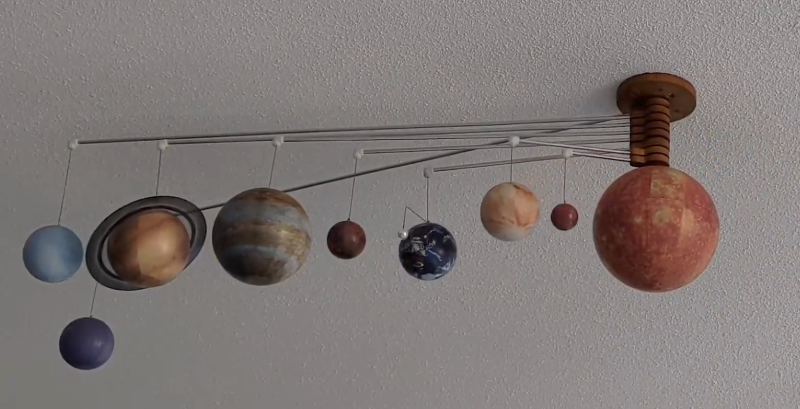Ever since humans figured out that planets move along predetermined paths in the heavens, they have tried to make models that can accurately predict their motion. Watchmakers and astronomers worked together to create orreries: mechanical contraptions that illustrate the positions of all planets and the way they move over time through complex gear systems. [Illusionmanager] continues the orrery tradition but uses a different approach: he built a beautiful ceiling-mounted model of our Solar System without a gearing system.
The mechanism that makes his Solar System tick is deceptively simple. All planets can move freely along their orbit’s axis except Mercury, which is moved along its orbit by a motor hidden inside the Sun. Once Mercury has completed a full revolution, a pin attached to its arm will begin pushing Venus along with it. After Venus has completed a full circle, its own pin will pick up Earth, and so on all the way to Neptune. Neptune is then advanced to its correct location as reported by NASA, after which Mercury’s motion is reversed and the whole procedure is repeated in the opposite direction to position Uranus.
Cycling through the entire Solar System in this way takes a long time, which is why the planets’ positions are only updated once a day at midnight. An ESP32, also hidden inside the Sun, connects to the internet to retrieve the correct positions for the day and drives the motor. The planet models, sourced from a museum shop, are hanging from thin aluminium tubes attached to wooden mounts made with a desktop CNC machine.
[Illusionmanager] made a detailed Instructables page showing the process of making a miniature version of the mechanism using just laser-cut wooden parts, as an update to a version we featured earlier. We really like the simplicity of this design, which stands in stark contrast to the huge gear trains used in more traditional orreries.

















Here is an additional picture of the whole mechanisme before putting it together https://drive.google.com/file/d/1ivrrCOzkYd2hoBmX4HOFnLbVnqO79KbN/view?usp=sharing
“Orrery” is one of my favourite words. I learned it when I was quite small (above five) and have been fascinated by it ever since.
except that this isn’t really an orrery. Orreries show the relative motion of the planets and rarely, if ever, show the correct orientation. This one shows the correct orientation (every day, but it has a web interface to pick any date between 9999 BC and 9999 AD). The motion itself is completely wrong, but you usually don’t see that because it happens during the night. That’s why I call this mechanism a Planet Spinner.
Didn’t you know that every few hours the planets get reversed in their paths to comply with the predictions of astrologists?
The relative scales of these balls are also completely off-planet. It is a nice looking ornament, but it does not have to do much with an Orrery. It makes me wonder why it does not have a flat Earth. That would have been fitting with the rest of the “artists interpretation”.
LOL, nothing to do with astrology or flat earth, this is about astronomy! (but you can get a flat version here https://www.aliexpress.com/item/4001178952994.html) Luckily it still sets all the planets in their right orientation (despite the wrong relative scale of the planets)
I love it and I want one.
+1. This is really, really clever.
Clever. But I don’t understand how you could do this and not make the sun an actual ceiling light!
He ran out of hydrogen.🌞
Not to mention how having a 5500C sun in your room, imagine the AC costs!
The frame inside the Sun that holds the motor, power supply and electronics would cast a very ugly shadow on the Sun’s surface.
Move the motor and esp into the ceiling box?
The air in my Sun contains about 0.00005% Hydrogen. Apparently enough to show a very faint blue glow if all the other lights are off, but it does give off at least some light.
Still haven’t got over Pluto being kicked out of the list….
Back in my day we had 9 planets!
I haven’t given up hope. I thought for sure they would reconsider after Horizon, but I guess some people don’t want to give up the fame (cough… Neil Tyson). Poor Clyde…RIP, if you can.
I think I would have just put a flat panel monitor on the ceiling and done the graphics in software. Prettier, and easier to dust, also.
Well, build one and be sure to submit your version to the HaD tip line.
Why would I want to do that?
So someone could comment about how it would really be better it was done mechanically for inane reasons.
actually Pluto was included in this set of planets, but I used it as a practice target to open it up and see what’s inside. Besides the aluminum tubes I used for the arm, had a length of 1m, not long enough to include Pluto. But I agree, for sentimental and historic reasons they should have kept Pluto.
But then Pluto”s orbit is tilted off the planetary plane and occasionally crosses within the orbit of Yourbuttass.
nah, only only crosses the orbit of Neptune (20 out of 248 years, the time for it’s orbit around the Sun). But in any case, this Planet Spinner only shows the orientation correctly. The distance from the Sun is not to scale, and all orbits are circular.
Eccentric orbits are for the next version with telescoping rods and cams in the hub.
a 5500K light source is however pretty common ;-)
that could work, with a big box on the ceiling. But I’m not sure that would look as good as it currently does.
This is quite like the way a combination lock works.
actually a combination lock was the inspiration, but apparently nobody applied this kind of mechanism to a planetarium/orrery before.